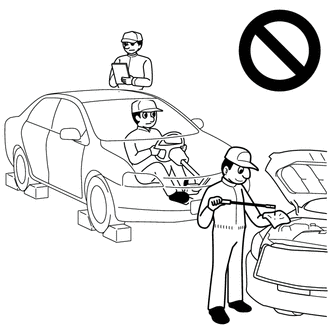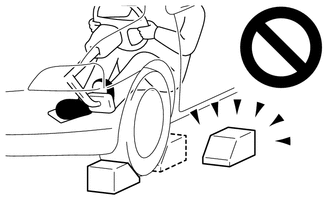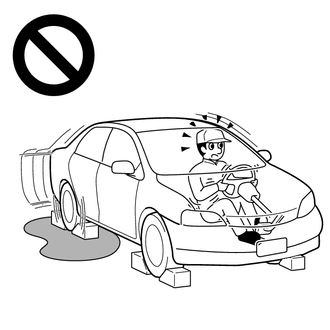- Engine power output may be insufficient
- Stator one-way clutch not operating properly
| Last Modified: 08-21-2023 | 6.11:8.1.0 | Doc ID: RM100000001RDRM |
| Model Year Start: 2021 | Model: Avalon | Prod Date Range: [08/2020 - ] |
| Title: UB80F (AUTOMATIC TRANSMISSION / TRANSAXLE): AUTOMATIC TRANSAXLE SYSTEM: MECHANICAL SYSTEM TESTS; 2021 - 2022 MY Avalon [08/2020 - ] | ||
MECHANICAL SYSTEM TESTS
STALL SPEED TEST
CAUTION:
-
Do not perform a stall test if there are any people or objects near the vehicle.

- The vehicle could begin moving suddenly, resulting in a serious accident.
-
Do not perform a stall test if any wheel chocks are out of position.

- The vehicle could begin moving suddenly, resulting in a serious accident.
-
Do not perform the stall test on a slippery or low-friction surface that could allow the tires to spin.

- The vehicle could begin moving suddenly, resulting in a serious accident.
NOTICE:
- Do not perform the stall speed test for longer than 5 seconds.
- When performing the stall speed test repeatedly, wait for 15 seconds or more between tests.
- Perform this test with the ATF (Automatic Transaxle Fluid) at the normal operating temperature: 50 to 80°C (122 to 176°F)
- Perform this test with the AUTO function (shift-linked function) of the electronic parking brake system off.
-
Check that there is no obstruction within 5 m (16.4 ft.) of the driving direction.
When torque is restricted by a safety function of the intelligent clearance sonar system, etc., the stall characteristics may not be normal.
HINT:
This test is to check the overall performance of the engine and transaxle.
(a) Connect the Techstream to the DLC3.
(b) Drive the vehicle until the transaxle fluid temperature has reached 50 to 80°C (122 to 176°F).
(c) Allow the engine to idle with the air conditioning and headlights off.
(d) Chock all 4 wheels.
(e) Set the parking brake and keep the brake pedal depressed firmly with your left foot.
HINT:
When the parking brake indicator (red) is illuminated after the electric parking brake switch (electric parking brake switch assembly) has been pulled to the lock side, the maximum amount of braking force is applied if the electric parking brake switch (electric parking brake switch assembly) is pulled to the lock side one more time.
(f) Move the shift lever to D.
(g) Depress the accelerator pedal as much as possible with your right foot.
(h) Read the engine speed (stall speed) and release the accelerator pedal immediately.
Standard Value:
|
Stall Speed |
|
|---|---|
|
2450 rpm |
+ 200 rpm |
|
- 300 rpm |
|
Evaluation
|
Test Result |
Possible Cause |
|---|---|
|
Stall speed is lower than standard value |
HINT: If the value is less than the specified value by 600 rpm or more, the torque converter assembly may be malfunctioning. |
|
Stall speed is higher than standard value |
|
NOTICE:
Perform this test with the AUTO function (shift-linked function) of the electronic parking brake system off.
SHIFT TIME LAG TEST
HINT:
When the shift lever is moved while the engine is idling, there will be a certain time lapse or lag before shock can be felt. This is used for checking the condition of the clutch and brake.
(a) Connect the Techstream to the DLC3.
(b) Drive the vehicle until the transaxle fluid temperature has reached 50 to 80°C (122 to 176°F).
(c) Allow the engine to idle with the air conditioning off.
(d) Set the parking brake and keep the brake pedal depressed firmly.
HINT:
When the parking brake indicator (red) is illuminated after the electric parking brake switch (electric parking brake switch assembly) has been pulled to the lock side, the maximum amount of braking force is applied if the electric parking brake switch (electric parking brake switch assembly) is pulled to the lock side one more time.
(e) Check the D position time lag.
(1) Move the shift lever to N and wait for 1 minute.
(2) Move the shift lever to D and measure the time until shock is felt.
(3) Repeat the 2 steps above 3 times, and calculate the average time of the 3 tests.
Standard Value:
D position time lag is less than 1.5 seconds
(f) Check the R position time lag.
(1) Move the shift lever to N and wait for 1 minute.
(2) Move the shift lever to R and measure the time until shock is felt.
(3) Repeat the 2 steps above 3 times, and calculate the average time of the 3 tests.
Standard Value:
R position time lag is less than 1.5 seconds
Evaluation
|
Test Result |
Possible Cause |
|---|---|
|
D position time lag exceeds standard value |
|
|
R position time lag exceeds standard value |
|
|
|
|